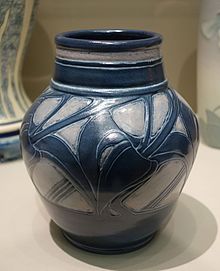
American art pottery (sometimes capitalized) refers to aesthetically distinctive hand-made ceramics in earthenware and stoneware from the period 1870-1950s. Ranging from tall vases to tiles, the work features original designs, simplified shapes, and experimental glazes and painting techniques. Stylistically, most of this work is affiliated with the modernizing Arts and Crafts (1880-1910), Art Nouveau (1890–1910), or Art Deco (1920s) movements, and also European art pottery.
Art pottery was made by some 200 studios and small factories across the country, with especially strong centers of production in Ohio (the Cowan, Lonhuda, Owens, Roseville, Rookwood, and Weller potteries) and Massachusetts (the Dedham, Grueby, Marblehead, and Paul Revere potteries). Most of the potteries were forced out of business by the economic pressures of competition from commercial mass-production companies as well as the advent of World War I followed a decade later by the Great Depression.[1]







